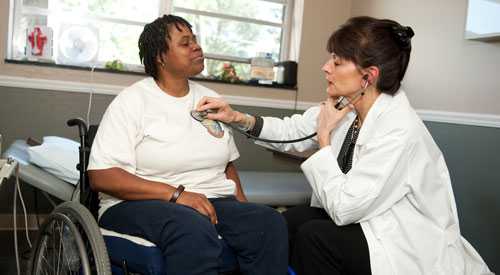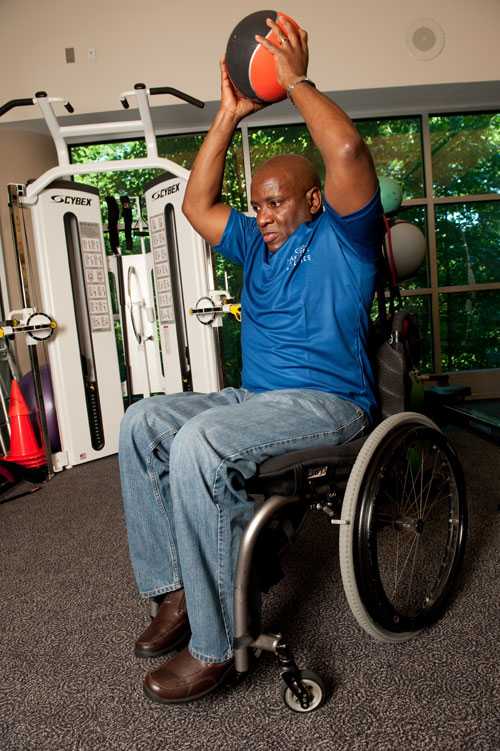People with Disabilities and High Blood Pressure

February is American Heart Month: Learn how everybody, including people with disabilities, can make lifestyle changes to keep blood pressure under control and help prevent heart disease.
High blood pressure, also known as hypertension, makes your heart work too hard and puts you at risk for heart disease and stroke, which are leading causes of death in the United States.1 About 1 of 3 US adults—about 70 million people—have high blood pressure.2
You can have high blood pressure and not know it. That is why it is so important to have your blood pressure checked. If you know family or friends who haven't had their blood pressure checked recently, make it a point to ask them to do it in February, American Heart Month.
It is easy to check blood pressure and it is painless. It can be checked by your doctor, and many pharmacies have free screenings.
What is your risk?
Having certain medical conditions can increase your chances of developing high blood pressure. These conditions include:
| Blood Pressure Levels | |
|---|---|
| Normal | Systolic: less than 120 mmHg Diastolic: less than 80 mmHg |
| At risk (prehypertension) | Systolic: 120-139 mmHg Diastolic: 80-89 mmHg |
| High | Systolic: 140 mmHg or higher Diastolic: 90 mmHg or higher |
Unhealthy behaviors can also increase your risk for high blood pressure, especially for people who have one of the medical conditions listed above. Unhealthy behaviors include:
- Eating a diet too high in sodium and too low in potassium
- Being obese
- Not getting enough physical activity
- Using tobacco
- Drinking too much alcohol
People with Disabilities and High Blood Pressure
Currently, high blood pressure affects approximately 30% of US adults. However, a greater percentage of adults with disabilities (34.2%) have high blood pressure than adults without disabilities (26.9%).3
Also, across all disability types, a greater percentage of adults with disabilities have high blood pressure than adults without any disability, but it is highest among adults with mobility limitations.
Percentage of US Adults ≥20 Years of Age who had High Blood Pressure by Disability Type, 2001-2010
In the United States alone, there are 21 million adults from 18-64 years of age, living with a disability.5 These are adults with serious difficulty walking or climbing stairs; hearing; seeing; or concentrating, remembering, or making decisions.5
Adults with disabilities are at an increased risk for heart disease and stroke, as they are more prone to many of the above risk factors.5 For example, people with disabilities have more difficulty in maintaining healthy weight than the general public due to a variety of factors, including accessibility issues that might influence their ability to get healthy foods.
Getting enough physical activity is recommended for everyone, but, for people with disabilities, getting the required physical activity often comes with challenges that the general public does not face.5
Thankfully, there are steps that everyone, regardless of ability, can take to keep blood pressure under control and reduce or eliminate risk factors to heart disease and stroke. Some of these steps include:
Reduce sodium intake. Most Americans consume too much sodium, which can raise blood pressure. Read about ways to reduce your sodiumand visit the Million Hearts® Healthy Eating & Lifestyle Resource Center for heart-healthy, lower-sodium recipes, meal plans, and helpful articles.
Maintain a healthy weight. Being overweight or obese can increase your risk for heart disease. To determine whether your weight is in a healthy range, doctors often calculate a number called the body mass index (BMI).
If you know your weight and height, you can calculate your BMI at CDC's Assessing Your Weight website.

Exercise regularly. Physical activity can help you maintain a healthy weight and lower cholesterol and blood pressure. The Surgeon General recommends all adults, regardless of ability, engage in moderate-intensity exercise for 2 hours and 30 minutes every week.
For more information, see CDC's Nutrition and Physical Activity Program website.
People with disabilities face obstacles in getting physical activity that don’t necessarily apply to the general public. However, doctors can recommend physical activity options that match each person’s specific abilities and connect them to resources that can help everyone of any ability get physical activity. See Resources for Doctors and Health Professionals to learn how doctors and other health professionals can play a role in promoting physical activity among their adult patients with disabilities.
See CDC Vital Signs™: Physical Activity is for Everybody for details on how people with disabilities can be physically active.
Don't smoke. The percentage of adults who smoke cigarettes is higher among people with disabilities than people without disabilities.6 Cigarette smoking greatly increases your risk for heart disease. So, if you don't smoke, don't start. If you do smoke, quitting will lower your risk for heart disease. Your doctor can suggest ways to help you quit.
For more information about tobacco use and quitting, see CDC’s Smoking and Tobacco website.
Limit alcohol use. Avoid drinking too much alcohol, which causes high blood pressure.
For more information, visit CDC's Alcohol and Public Health website.
About CDC’s Disability and Health Program
CDC supports 18 state-based disability and health programs and four National Public Health Practice and Resource Centers (NPHPRC), which promote healthy lifestyles and improve quality of life for people with disabilities. CDC monitors the health of people with and without disabilities and supports the inclusion of people with disabilities in public health programs that prevent disease and promote healthy behaviors while working to eliminate barriers to health care and improve access to routine preventive services.
More information:
To learn more about Disability and Health, please visit https://www.cdc.gov/ncbddd/disabilityandhealth/index.html.
To learn more about high blood pressure, please visit https://www.cdc.gov/bloodpressure/index.htm.
References
- Go AS, Mozaffarian D, Roger VL, Benjamin EJ, Berry JD, et al. Heart disease and stroke statistics—2013 update: a report from the American Heart Association. Circulation. 2013;127:e6–e245.
- 1.CDC. Vital signs: awareness and treatment of uncontrolled hypertension among adults—United States, 2003–2010. MMWR. 2012;61:703-9.
- Stevens A, Courtney-Long E, Gillespie C, Armour BS. Hypertension Among US Adults by Disability Status and Type, National Health and Nutrition Examination Survey, 2001–2010. Prev Chronic Dis 2014;11:140162. DOI: http://dx.doi.org/10.5888/pcd11.140162.
- Centers for Disease Control and Prevention. Heart Disease Fact Sheet. [updated 2014 August 20; cited 2015 January 1]. Available from: https://www.cdc.gov/dhdsp/data_statistics/fact_sheets/fs_heart_disease.htm .
- Centers for Disease Control and Prevention. CDC Vital Signs™: Physical Activity is for Everybody. [updated 2014 May 6; cited 2015 January 1]. Available from: https://www.cdc.gov/vitalsigns/disabilities/index.html
- MMWR Report includes people with disabilities: Current Cigarette Smoking Among Adults — United States, 2011. Available at https://www.cdc.gov/mmwr/preview/mmwrhtml/mm6144a2.htm?s_cid=mm6144a2_w
- Page last reviewed: February 9, 2015
- Page last updated: February 9, 2015
- Content source:


 ShareCompartir
ShareCompartir